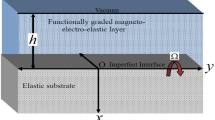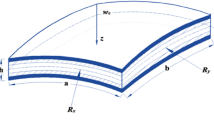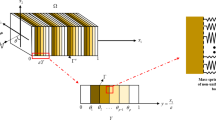Abstract
This paper experimentally and numerically investigates the axial decay of end effects in a cylindrical waveguide under transient loading. End effects, which are defined as an edge response deviating from that of the far field response, are analyzed by applying waves with different spatial distribution on the edge of a waveguide. Four impactors having the same cross-sectional area but different head shapes are impinged upon a long cylindrical waveguide. Surface strains at different locations along the waveguide are recorded and compared. Results from both the experimental and numerical studies indicate that the far field response is not sensitive to the spatial distribution of the applied transient loading. The typical distance beyond which the end effects could be ignored is estimated to be about 2.2 times of the bar radius. These results provide evidence on the existence of dynamic version of Saint-Venant’s principle in cylindrical waveguides in high frequency regime.









Similar content being viewed by others
References
Karp B, Durban D (2005) Evanescent and propagating waves in prestretched hyperelastic plates. Int J Solids Struct 42:1613–1647
Karp B (2005) Dynamic version of Saint-Venat’s principle—historical account and recent results. Nonlinear Anal 63:e931–e942
Karp B (2009) Dynamic equivalence, self-equilibrated excitation and Saint-Venant’s principle for an elastic strip. Int J Solids Struct 46:3068–3077
Boley BA (1955) The application of Saint-Venant’s principle in dynamical problems. J Appl Mech 22:204–206
Karp B, Durban D (2011) Saint-Venant’s principle in dynamics of structures. Appl Mech Rev 64(2):020801
Meng H, Li QM (2001) Modification of SHPB set-up based on wave separation technique and dynamic Saint-Venant’s principle. In: Chau FS, Quan C (eds) Second international conference on experimental mechanics, Proc SPIE Int Soc Opt Eng 4317:85–93
Horgan CO, Simmonds JG (1994) Saint-Venant’s end effects in composite structures. Comput Eng 4:279–286
Karp B, Dorogoy A, Wang Z (2009) Non-uniform impact excitation of a cylindrical bar. J Sound Vib 323:757–771
Wu E, Tsai CZ, Tseng LH (1998) A deconvolution method for force reconstruction in rods under axial impact. J Acoust Soc Am 104:1418–1426
He L, Ma GW, Karp B, Li QM (2014) Evaluation of dynamic Saint-Venant’s principle: part II - analytical approach. Int J Impact Eng 73:135–144
Bell JF (1973) The experimental foundations of solid mechanics. In: der Phys HNBK, Flugge S (eds) Mechanics of solids, vol VIa/1. Springer, New-York
Karp B, Rittel D, Durban D (2008) Health monitoring of joints using dynamic end effects. J Sound Vib 312(1–2):257–272
Tokyo Sokki Kenkyujo Co., Ltd, “F series Leadwire integrated Foil strain gauge”, (http://www.tml.jp/e/product/strain_gauge/index.html)
Seiji K, Shinobu ITO, Yukihito T, Takaaki M (1999) Datasheet of digital scope DL708E, Yokogawa Technical Report, No.26
ANSYS/LSDYNA User’s Manual—Version 9.0. ANSYS. Incorporated Corporation, 2002.
Oasys (2014) D3PLOT 11.0 manual, Oasys 11.1 Release_Notes (http://www.oasys-software.com/dyna/en/downloads/oasys_software/11/manuals/d3plot.pdf)
MatWeb (2014) Online material information resource, MatWeb, LLC, Blacksburg, VA 24060 USA (http://www.matweb.com)
Folk R, Fox G, Shook CA, Curtis CW (1958) Elastic strain produced by sudden application of pressure to one end of a cylindrical bar. I. theory. J Acoust Soc Am 30(6):552–558
Meng H, Li QM (2003) An SHPB set-up with reduced time-shift and pressure bar length. Int J Impact Eng 28:677–696
Lok TS, Zhao PJ, Lu G (2003) Using the split Hopkinson pressure bar to investigate the dynamic behaviour of SFRC. Mag Concr Res 55:183–191
Gray GTIII (2000) Classic split-Hopkinson pressure bar testing. In: Kuhn H, Medlin D (eds) ASM handbook: mechanical testing and evaluation, vol 8. ASM International, Materials Park, pp 462–476
Acknowledgments
The present work is funded by the National Science Foundation of China (Grant Nos. 11402070), and financial supports received from the Underground Technology and Rock Engineering (UTRE) Program and the Nanyang Centre for Underground Space (NCUS), Nanyang Technological University, Singapore. These supports are gratefully acknowledged.
Author information
Authors and Affiliations
Corresponding author
Rights and permissions
About this article
Cite this article
He, L., Ma, G.W., Karp, B. et al. Investigation of Dynamic Saint-Venant’s Principle in a Cylindrical Waveguide—Experimental and Numerical Results. Exp Mech 55, 623–634 (2015). https://doi.org/10.1007/s11340-014-9974-z
Received:
Accepted:
Published:
Issue Date:
DOI: https://doi.org/10.1007/s11340-014-9974-z




